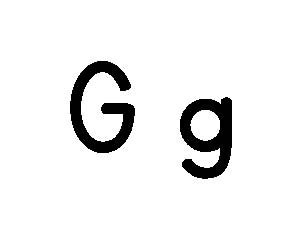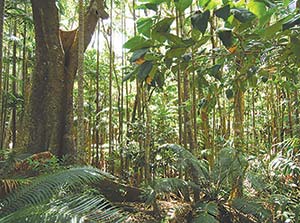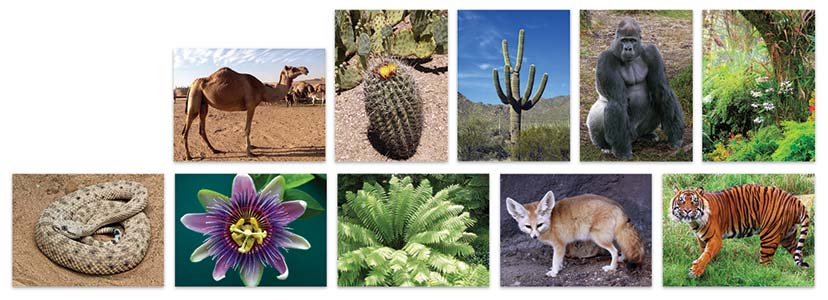Oral language, Letter knowledge
Children will understand basic information, including the meaning of several novel words, presented in a book read aloud. Children will also identify the name and sound of the letter G.


New:
Be Prepared: This is the first of three repeated readings of a book with children. Today’s reading focuses on children’s understanding of basic information presented in the book. In advance of the session, identify all novel words in the book you intend to define for children across three days of reading the book. Select one or two important words to define for children today, especially words that are essential to understanding the book. See the Language/Literacy section of the ELM User Guide: 3–5 Years for additional information. Write the following at the top of the chart paper: Words We Understand.
 [Display letter G card.]
[Display letter G card.]
The word “graph” begins with this letter. What is the name of this letter?
Letter G says /g/, just like in the word “graph” /g/, /g/, graph. Let’s together say /g/, /g/, graph.
Who would like to tell us another word that begins with the letter G?
Now let’s read a book!
[See Week 3, Day 1 of Language/Literacy for a description and examples of how to approach today’s book reading. Key aspects are summarized below:
Number knowledge
Children will add animals to a group and take away animals from a group.


New:
Review:

Last week we practiced adding together groups of items. We know that something gets larger when we add items to it. We also practiced taking away items from a group. What is it called when we take away items from a group? (subtract)
Today we will act out a story. In the story, we will add and subtract.
[Invite three volunteer children to stand near you to help with the story. Give the first child one stuffed animal, the second child two stuffed animals, and the third child three stuffed animals. Explain to children that the stuffed animals are pretend pets. Then line up three chairs.]
Our story is about some pets that went to the veterinarian. A veterinarian is a doctor for animals. Sometimes a veterinarian is called a vet.
Have you ever taken a pet to the vet?
Let’s listen carefully to our story.
One day a child went to a veterinarian’s office with a puppy that was sick. The child sat in a chair with the puppy and waited for a turn to see the veterinarian.
[Guide the child with one stuffed animal to a chair.]
Next another child arrived with two kittens that needed a checkup. The child with the two kittens sat in a chair next to the first child with the sick puppy.
[Guide the child with two stuffed animals to a chair next to the first child.]
Let’s figure out how many animals are waiting to see the veterinarian. To see how many animals there are all together, count on to add the number of animals in both groups. We will start with the number of animals in our largest group, and then count on to the animal in our other group.
[Point to each animal as you lead children in counting on. Example: “There is a group of two animals and a group of one animal. Two animals is a larger group than one animal. We will begin counting with the number two.” Continue counting the animal in the second group. Encourage children to count out loud with you: “2, 3.”]
There are three animals all together.
As the children and animals were waiting for their turn, another child arrived with two bunnies. The two bunnies needed to get shots. The child with the bunnies sat next to the child with the kittens.
[Guide the child with two stuffed animals to a chair next to the second child.]
Let’s count on to see how many animals there are all together. We will start with the number of animals in our largest group, and then count on to the animals in our other group.
[Point to each animal as you lead children in counting on. Example: “We know there are three animals already here and now a group of two animals just arrived. Three animals is a larger group than two animals. We will begin counting with the number three.” Continue counting the animals in the second group. Encourage children to count out loud with you: ”3, 4, 5.”]
Now there are five animals in the veterinarian’s office.
Finally it was the sick puppy’s turn to see the veterinarian. The child with the puppy left his/her chair.
[Guide the child with one stuffed animal back to his/her seat on the floor.]
We will begin to subtract the animals in our group. We know that subtract means to take away something from a group of things.
We started with five animals and one went away. We subtracted one animal from our group of five animals.
How many animals are waiting now? Let’s count them.
[Lead children in counting the number of animals left waiting while pointing to animals as you count each.]
Now there are four animals waiting.
Next it was time for the two kittens to see the veterinarian. The child with the two kittens left his/her chair.
[Guide the child with two stuffed animals back to his/her seat on the floor.]
There were four animals waiting and two went away. We subtracted two animals from our group of four animals.
How many animals are waiting now? Let’s count them.
[Lead children in counting the number of animals left waiting while pointing to animals as you count each.]
Now there are two animals waiting.
It was time for the two bunnies to see the veterinarian. The child with the two bunnies left his/her chair.
[Guide the child with two stuffed animals back to his/her seat on the floor.]
We had two animals and they left to see the veterinarian.
How many animals are left waiting now? (zero) We know that zero means none. There are no more animals waiting to see the veterinarian.
[If time permits:
Create and tell your own addition and subtraction stories that children can enact.]
Today we listened to a story about three children who took their animals to the vet. We added and subtracted animals as we listened to the story. How many animals were left at the end of our story? (zero)
Extra support
Enrichment
Add several stuffed animals to the housekeeping center. Encourage children to add and subtract stuffed animals as they play.
Share additional stories throughout the day to encourage adding and subtracting. Examples: children playing with toys outside, children eating a number of items at lunch.
Executive function
Children will regulate their behaviors in response to changes in visual, oral, and aural prompts.


Review:
Be Prepared: Hang each of the following shapes on different walls in the classroom: two yellow triangles, two yellow squares, two blue circles, and two blue rectangles.
If time permits, offer Conducting an Orchestra from Week 31, Day 2 as a second game. If the game described below is too challenging for a majority of children, stop at an appropriate place and offer Conducting an Orchestra from Week 31, Day 2. The game for today may be less challenging when offered again at a later point.
Today we will play a game we’ve played before. We will play Orange Circle, Purple Circle. This game helps us learn how to focus our attention on what we are expected to do. We know that when we focus on something, we concentrate on it.
Today, we are going to play our game with colored shapes and change the rules of the game. I have a yellow triangle and a yellow square.
[Hold up both shapes.]
Let’s try wiggling our hips when we see the yellow triangle, and stopping when we see the yellow square.
[Hold up the yellow triangle for a few seconds and encourage children to wiggle their hips. Then hold up the yellow square and encourage children to stop. Do this several times. If children readily follow the changes, vary the timing of holding up the action shape. Example: Hold up yellow triangle for 10 seconds, then hold it up for five seconds, etc.]
We just wiggled our hips when we saw the yellow triangle, and stopped when we saw the yellow square.
Now let’s change the rules of our game. This time we will wiggle our hips when we see the yellow square, and stop when we see the yellow triangle.
[Hold up the yellow square for a few seconds and encourage children to wiggle their hips. Then hold up the yellow triangle and encourage children to stop. Do this several times. If children readily follow the changes, vary the timing of holding up the action shape. Example: Hold up yellow square for 10 seconds, then hold it up for five seconds, etc.]
Let’s play our game again. This time we will use two different shapes and change the rules of the game.
[Hold up each shape as you demonstrate the body movement that corresponds with each.]
Let’s see if we remember what we need to do for each new shape.
Let’s practice!
[Continue playing the game as you hold up each shape. Be sure to clearly say “Blue Circle!” and “Blue Rectangle!” when you hold up the shapes for all to see. Hold up each shape for several seconds. Then put the shapes behind your back.
If children follow the prompts without much difficulty, then do the opposite motions for each shape. Be sure to review the game changes before you begin a new version.]
Today we played Orange Circle, Purple Circle again. We paid close attention to what we were expected to do and remembered new rules.
Extra support
Enrichment
Provide the colored shapes used during today’s activity. Invite children to continue playing Orange Circle, Purple Circle. Encourage children to take turns holding the shapes and naming the action to be done each time.
Send the new game rules home with children and encourage them to explain the new rules to family members at pickup time. Invite families to play at home.
Knowledge of habitats
Children will understand basic characteristics of a rainforest, including the rainforest floor.


New:
Review:

We are learning about different types of habitats. What is a habitat? (a place where certain types of plants and animals usually live)
Several weeks ago we learned about a forest habitat.
What do you remember about a forest? (covered with trees and other plants, brown and green, many plants and animals live there)
This week we will learn about a habitat called a rainforest. A rainforest is a forest that gets a lot of rain and has very tall trees. Sometimes a rainforest is called a jungle.
The word rainforest is a compound word. We know that a compound word is the new word we make by putting two words together.
What two words do you hear in the word rainforest? (rain, forest)
 Let’s look at a picture of a rainforest.
Let’s look at a picture of a rainforest.
[Display picture of a rainforest.]
[Encourage children to discuss what they know about a rainforest.]
It rains in a rainforest almost every day. A rainforest has more kinds of plants and animals than any other habitat in the world because it rains so much.
Today we are going to talk about some things that live on the ground of a rainforest. The ground is soil. We call this part of a rainforest the rainforest floor.
[Point to the floor in the rainforest picture.]
Many kinds of plants, insects, and other large animals live on a rainforest floor. Let’s look at some pictures of some animals and plants that live on a rainforest floor.
[Display the following pictures of plants and animals that live on a rainforest floor: tiger, gorilla, ferns, and flowers. Children are not expected to remember the specific names. Name each animal and plant and encourage discussion of its characteristics with questions, such as the following:]
[Point to the tall trees in the rainforest picture as you describe how they provide shade for the rainforest floor. Point also to a leafy and green plant on the rainforest floor.]
The plants on a rainforest floor are very leafy and green because a rainforest gets lots of rain. These plants do not need a lot of sunlight to grow. The rainforest floor gets a small amount of sunshine. Tall trees and other tall plants grow above the rainforest floor and provide shade for the plants below.
[Display together the pictures of a rainforest and a desert.]
Let’s compare a rainforest habitat to a desert habitat. Remember, there is a lot of sun and very little rain in a desert.
Desert plants get a lot of sun but not a lot of rain. Rainforest plants get a lot of rain but not a lot of sun. A rainforest and a desert are very different places for plants and animals.
Many plants and animals live in a rainforest because it rains almost every day. There are more plants and animals in a rainforest than in any other habitat. The rainforest floor gets very little sunlight because the tall trees and other plants that grow above it provide shade for the plants below.
Extra support
Enrichment
Provide *rainforest and desert animals and plants sorting cards. Encourage children to sort the pictures by habitat.
*Printables provided

Take a trip to a park. Look at the various plants that live on the ground. Are they in the shade of a tree or other plant? Discuss how some plants need less sunlight to live than others.